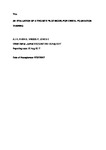An evaluation of a two-site pilot model for dental foundation training
| dc.contributor.author | Ali, Kamran | |
| dc.contributor.author | Khan, S | |
| dc.contributor.author | Briggs, P | |
| dc.contributor.author | Jones, E | |
| dc.date.accessioned | 2018-05-01T15:14:52Z | |
| dc.date.issued | 2017-08-25 | |
| dc.identifier.issn | 0007-0610 | |
| dc.identifier.issn | 1476-5373 | |
| dc.identifier.uri | http://hdl.handle.net/10026.1/11390 | |
| dc.description.abstract |
Objectives To evaluate the feasibility, strengths, weaknesses, and challenges of a two-site model of dental foundation training.Methods A mixed methods approach was used to evaluate the two-site pilot. Qualitative interviews and focus groups were employed to gain an in-depth understanding of the expectations, experiences and concerns of the stakeholders. Additionally, purposefully designed questionnaires were used to rate different elements of the training.Results Participants included 12 foundation dentists, 15 educational supervisors and seven assistant educational supervisors. An increased breadth of clinical experience, a more variable case-mix, feedback from two teams of supervisors, and the experience of working within two different practices with two different teams and cultures were perceived to be the main strengths. The key challenges reported by the trainers were increased workload, a perceived disruption to the continuity of patient-care and perceived difficulties in establishing professional relationships.Conclusions This paper reports on the evaluation of a new model of dental foundation training in London. It highlights potential advantages and drawbacks of providing dental foundation training in two dental practices. Given the limitations of the of evaluation reported in this paper, additional work is required to establish the feasibility and effectiveness of the two-site training model. | |
| dc.format.extent | 287-292 | |
| dc.format.medium | ||
| dc.language | en | |
| dc.language.iso | en | |
| dc.publisher | Nature Publishing Group | |
| dc.subject | Education, Dental | |
| dc.subject | England | |
| dc.subject | Models, Educational | |
| dc.subject | Pilot Projects | |
| dc.subject | Self Report | |
| dc.subject | Vocational Education | |
| dc.title | An evaluation of a two-site pilot model for dental foundation training | |
| dc.type | journal-article | |
| dc.type | Article | |
| plymouth.author-url | https://www.webofscience.com/api/gateway?GWVersion=2&SrcApp=PARTNER_APP&SrcAuth=LinksAMR&KeyUT=WOS:000410489100016&DestLinkType=FullRecord&DestApp=ALL_WOS&UsrCustomerID=11bb513d99f797142bcfeffcc58ea008 | |
| plymouth.issue | 4 | |
| plymouth.volume | 223 | |
| plymouth.publication-status | Published | |
| plymouth.journal | British Dental Journal | |
| dc.identifier.doi | 10.1038/sj.bdj.2017.714 | |
| plymouth.organisational-group | /Plymouth | |
| plymouth.organisational-group | /Plymouth/Faculty of Health | |
| plymouth.organisational-group | /Plymouth/Users by role | |
| dc.publisher.place | England | |
| dcterms.dateAccepted | 2017-07-12 | |
| dc.rights.embargodate | 2018-6-20 | |
| dc.identifier.eissn | 1476-5373 | |
| dc.rights.embargoperiod | 6 months | |
| rioxxterms.versionofrecord | 10.1038/sj.bdj.2017.714 | |
| rioxxterms.licenseref.uri | http://www.rioxx.net/licenses/under-embargo-all-rights-reserved | |
| rioxxterms.licenseref.startdate | 2017-08-25 | |
| rioxxterms.type | Journal Article/Review |


